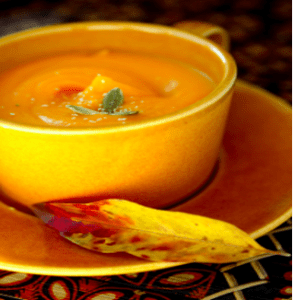Written by UConn Dietetics Student Alexa Horkachuck
Autumn is finally here, which means that pumpkin flavored products are flooding into your local grocery store. If you’re a fan, you will find everything from pumpkin cream cheese and pumpkin spice lattes to pumpkin pastas and soups. There is bound to be a recipe that you would enjoy making and eating!
 Pumpkin is a tasty vegetable that is packed with healthful benefits for you and your family to enjoy. It is low in calories, sodium, and fat, while high in fiber to help keep you full throughout the day. It is also a great source of beta-carotene which your body converts to vitamin A – a powerful antioxidant which helps improve your skin and eye health. Pumpkin also has vitamin C to keep your immune system strong through the upcoming winter. It also is packed with potassium, and low in sodium which can help prevent high blood pressure!
Pumpkin is a tasty vegetable that is packed with healthful benefits for you and your family to enjoy. It is low in calories, sodium, and fat, while high in fiber to help keep you full throughout the day. It is also a great source of beta-carotene which your body converts to vitamin A – a powerful antioxidant which helps improve your skin and eye health. Pumpkin also has vitamin C to keep your immune system strong through the upcoming winter. It also is packed with potassium, and low in sodium which can help prevent high blood pressure!
When cooking with fresh pumpkin, it is important to pay attention to what type of pumpkin you are using and how much of the pumpkin you need to use! For cooking at home, purchase fresh sugar-pumpkins (also called pie or sweet pumpkins), which are small and round. Field types of pumpkins are larger, have watery, stringy flesh, and are best used for decorating like Jack-O-Lanterns.
Check this out to learn about different types of pumpkins!
https://www.thekitchn.com/the-best-pumpkins-for-baking-ingredient-intelligence-211333
Fresh pumpkin is easy to prepare in an oven, check it out!
https://www.thespruceeats.com/how-to-roast-pumpkin-4115845
You can replace fresh, pureed pumpkin with equal amounts of canned pumpkin in your favorite recipes. For example, substitute 1 cup fresh, pureed pumpkin called for in a recipe with 1 cup canned pumpkin.
- Canned pumpkin is certainly more convenient and relatively inexpensive, typically costing around $1-2 for a 15-oz can. Be sure to buy 100% pure pumpkin and not pumpkin pie filling or pumpkin pie “mix” by accident! The “filling and mix styles” add unwanted sugars that you do not need in most recipes.
- Once opened, canned pumpkin can be stored in your refrigerator for up to 5-7 days. You can also stir canned pumpkin into oatmeal, pancakes, smoothies, and vanilla yogurt for added flavor. Add it to soups and stews to thicken them.
- Be sure to transfer any leftover canned pumpkin to an airtight container and store in the fridge.
Here are two delicious ways to use fresh or canned pumpkin. For more tasty, healthy, and low-cost recipes, visit: https://communitynutrition.cahnr.uconn.edu/recipes/
Ingredients:
1 tbsp butter
½ small onion, finely chopped
1 can (15 oz.) solid packed pumpkin
2 cups water
½ cup milk
1 tbsp. maple syrup
¼ tsp. salt
Freshly ground pepper to taste
Instructions
- Melt butter in a large saucepan over medium heat; add onion and cook, stirring often until very soft, about 8 minutes. Do not burn.
- Add pumpkin, water, milk, syrup, salt, and pepper; bring to a boil.
- Reduce heat and simmer for 10 minutes, whisking often.
- Let cool and then cover and chill. Bring to a simmer before serving.
Pumpkin Apple Cake Serves: 24
Ingredients:
1 package white cake mix
1 can (15 oz.) pumpkin puree
1 tsp. cinnamon
⅔ cup apple juice
3 eggs
1 tsp. vanilla
Nonstick cooking spray and flour
Instructions:
- Preheat oven to 350℉.
- Combine cake mix, pumpkin, cinnamon, apple juice, eggs, and vanilla in a large mixing bowl.
- Beat at low speed for 30 seconds. Beat at medium speed for 2 minutes.
- Pour into a 12 cup Bundt pan or a 9” x 13” cake pan that has been sprayed with cooking spray and floured.
- Bake for 35-40 minutes or until a wooden toothpick inserted in the cake center comes out clean.
- Cool for 10 minutes. Then invert onto wire rack to cool completely
—
This material was funded by USDA’s Supplemental Nutrition Assistance Program (SNAP).
This institution is an equal opportunity provider.
